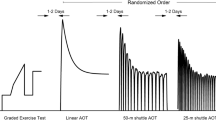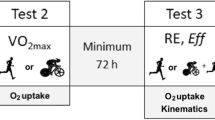Abstract
The aim of the present study was to determine the best pacing strategy to adopt during the initial phase of a short distance triathlon run for highly trained triathletes. Ten highly trained male triathletes completed an incremental running test to determine maximal oxygen uptake, a 10-km control run at free pace and three individual time-trial triathlons (1.5-km swimming, 40-km cycling, 10-km running) in a randomised order. Swimming and cycling speeds were imposed as identical to the first triathlon performed and the first run kilometre was done alternatively 5% faster (Tri-Run+5%), 5% slower (Tri-Run−5%) and 10% slower (Tri-Run−10%) than the control run (C-Run). The subjects were instructed to finish the 9 remaining kilometres as quickly as possible at a free self-pace. Tri-Run−5% resulted in a significantly faster overall 10-km performance than Tri-Run+5% and Tri-Run−10% (p < 0.05) but no significant difference was observed with C-Run (p > 0.05) (2,028 ± 78 s vs. 2,000 ± 72 s, 2,178 ± 121 s and 2,087 ± 88 s, for Tri-Run−5%, C-Run, Tri-Run+5% and Tri-Run−10%, respectively). Tri-Run+5% strategy elicited higher values for oxygen uptake, ventilation, heart rate and blood lactate at the end of the first kilometre than the three other conditions. After 5 and 9.5 km, these values were higher for Tri-Run−5% (p < 0.05). The present results showed that the running speed achieved during the cycle-to-run transition is crucial for the improvement of the running phase as a whole. Triathletes would benefit to automate a pace 5% slower than their 10-km control running speed as both 5% faster and 10% slower running speeds over the first kilometre involved weaker overall performances.


Similar content being viewed by others
References
Abbiss CR, Laursen PB (2008) Describing and understanding pacing strategies during athletic competition. Sports Med 38:239–252
Ansley L, Robson PJ, St Clair Gibson A, Noakes TD (2004) Anticipatory pacing strategies during supramaximal exercise longer than 30 s. Med Sci Sports Exerc 36:309–314
Beaver WL, Wasserman K, Whipp BJ (1986) A new method for detecting anaerobic threshold by gas exchange. J Appl Physiol 60:2020–2027
Bentley DJ, Millet GP, Vleck VE, McNaughton LR (2002) Specific aspects of contemporary triathlon. Sports Med 32:345–359
Bernard T, Vercruyssen F, Mazure C, Gorce P, Hausswirth C, Brisswalter J (2007) Constant versus variable-intensity during cycling: effects on subsequent running performance. Eur J Appl Physiol 99:103–111
Billat VL, Slawinski J, Danel M, Koralsztein JP (2001) Effect of free versus constant pace on performance and oxygen kinetics in running. Med Sci Sports Exerc 33:2082–2088
Boussana A, Matecki S, Galy O, Hue O, Ramonatxo M, Le Gallais D (2001) The effect of exercise modality on respiratory muscle performance in triathletes. Med Sci Sports Exerc 33:2036–2043
Esteve-Lanao J, Foster C, Seiler S, Lucia A (2007) Impact of training intensity distribution on performance in endurance athletes. J Strength Cond Res 21:943–949
Fiskestrand A, Seiler KS (2004) Training and performance characteristics among Norwegian international elite rowers 1970–2001. Scand J Med Sci Sports 14:303–310
Foster C, Snyder AC, Thompson NN, Green MA, Foley M, Schrager M (1993) Effect of pacing strategy on cycle time trial performance. Med Sci Sports Exerc 25:383–388
Foster C, Hendrickson KJ, Peyer K, Reiner B, de Koning JJ, Lucia A, Battista RA, Hettinga FJ, Porcari JP, Wright G (2009) Pattern of developing the performance template. Br J Sports Med 43:765–769
Galy O, Hue O, Boussana A, Peyreigne C, Couret I, Le Gallais D, Mercier J, Préfaut C (2003) Effects of the order of running and cycling of similar intensity and duration on pulmonary diffusing capacity in triathletes. Eur J Appl Physiol 90:489–495
Gandevia SC (2001) Spinal and supraspinal factors in human muscle fatigue. Physiol Rev 81:1725–1789
Gottshall JS, Palmer BM (2002) The acute effects of prior cycling cadence on running performance and kinematics. Med Sci Sports Exerc 34:1518–1522
Hausswirth C, Brisswalter J (2008) Strategies for improving performance in long duration events: Olympic distance triathlon. Sports Med 38:881–891
Hausswirth C, Bigard AX, Berthelot M, Thomaïdis M, Guezennec CY (1996) Variability in energy cost of running at the end of a triathlon and a marathon. Int J Sports Med 17:572–579
Hausswirth C, Bigard AX, Guezennec CY (1997) Relationships between running mechanics and energy cost of running at the end of a triathlon and a marathon. Int J Sports Med 18:330–339
Hausswirth C, Lehénaff D, Dréano P, Savonen K (1999) Effects of cycling alone or in a sheltered position on subsequent running performance during a triathlon. Med Sci Sports Exerc 31:599–604
Hausswirth C, Vallier JM, Lehénaff D, Brisswalter J, Smith D, Millet G, Dreano P (2001) Effect of two drafting modalities in cycling on running performance. Med Sci Sports Exerc 33:485–492
Hausswirth C, Le Meur Y, Couturier A, Bernard T, Brisswalter J (2009) Accuracy and repeatability of the Polar® RS800sd to evaluate stride rate and running speed. Int J Sports Med 30:354–359
Hettinga FJ, de Koning JJ, Broersen FT, Van Geffen P, Foster C (2006) Pacing strategy and the occurrence of fatigue in 4000-m cycling time trials. Med Sci Sports Exerc 38:1484–1491
Hill NS, Jacoby C, Farber W (1991) Effect of an endurance triathlon on pulmonary function. Med Sci Sports Exerc 23:1260–1264
Howley ET, Bassett DR Jr, Welch HG (1995) Criteria for maximal oxygen uptake: review and commentary. Med Sci Sports Exerc 27:1292–1301
Kreider RB, Cundiff DE, Hammett JB, Cortes CW, William KW (1988) Effect of cycling on running performance in triathletes. Ann Sports Med 3:220–225
Le Meur Y, Hausswirth C, Dorel S, Bignet F, Brisswalter J, Bernard T (2009) Influence of gender on pacing adopted by elite triathletes during a competition. Eur J Appl Physiol 106:535–545
Mauger AR, Jones AM, Williams CA (2009) Influence of feedback and prior experience on pacing during a 4-km cycle time trial. Med Sci Sports Exerc 41:451–458
Micklewright D, Papadopoulou E, Swart J Dr, Noakes TD (2009) Previous experience influences pacing during 20-km time trial cycling. Br J Sports Med. doi:10.1136/bjsm.2009.057315
Millet GP, Vleck VE (2000) Physiological and biomechanical adaptations to the cycle to run transition in Olympic triathlon: review and practical recommendations for training. Br J Sports Med 34:384–390
Seiler KS, Kjerland GO (2006) Quantifying training intensity distribution in elite endurance athletes: is the evidence for an ‘optimal’ distribution? Scand J Med Sci Sports 16:49–56
Thompson KG, MacLaren DP, Lees A, Atkinson G (2003) The effect of even, positive and negative pacing on metabolic, kinematic and temporal variables during breaststroke swimming. Eur J Appl Physiol 88:438–443
Tucker R (2009) The anticipatory regulation of performance: the physiological basis for pacing strategies and the development of a perception-based model for exercise performance. Br J Sports Med 43:392–400
Ulmer HV (1996) Concept of an extracellular regulation of muscular metabolic rate during heavy exercise in humans by psychophysiological feedback. Experientia 52:416–420
Vercruyssen F, Suriano R, Bishop D, Hausswirth C, Brisswalter J (2005) Cadence selection affects metabolic responses during cycling and subsequent running time to fatigue. Br J Sports Med 39:267–272
Vleck VE, Bürgi A, Bentley DJ (2006) The consequences of swim, cycle, and run performance on overall result in elite Olympic distance triathlon. Int J Sports Med 27:43–48
Vleck VE, Bentley DJ, Millet GP, Bürgi A (2008) Pacing during an elite Olympic distance triathlon: comparison between male and female competitors. J Sci Med Sport 11:424–432
Acknowledgments
This study was made possible by technical support from the French National Institute of Sport and Physical Education, the French Federation of Triathlon and the Universities of South Toulon-Var and Nice-Sophia Antipolis. The authors are especially grateful to the athletes and coaches for their help and cooperation. They also gratefully acknowledge Jessica Harrison for her help in the correction of this manuscript.
Conflict of interest statement
The authors declare that they have no conflict of interest.
Author information
Authors and Affiliations
Corresponding author
Additional information
Communicated by Klaas Westerterp.
Rights and permissions
About this article
Cite this article
Hausswirth, C., Le Meur, Y., Bieuzen, F. et al. Pacing strategy during the initial phase of the run in triathlon: influence on overall performance. Eur J Appl Physiol 108, 1115–1123 (2010). https://doi.org/10.1007/s00421-009-1322-0
Accepted:
Published:
Issue Date:
DOI: https://doi.org/10.1007/s00421-009-1322-0




